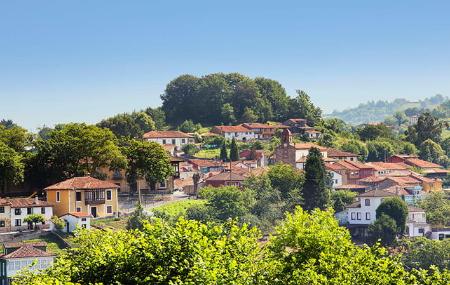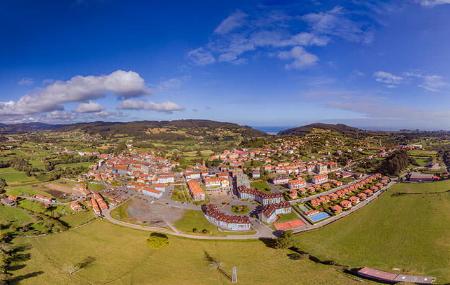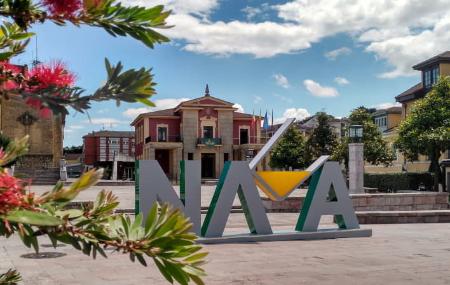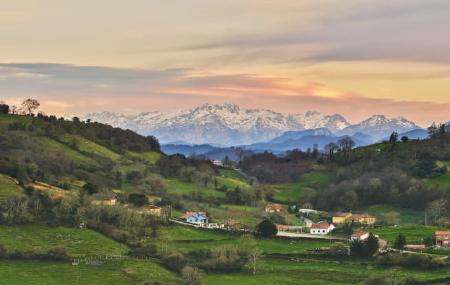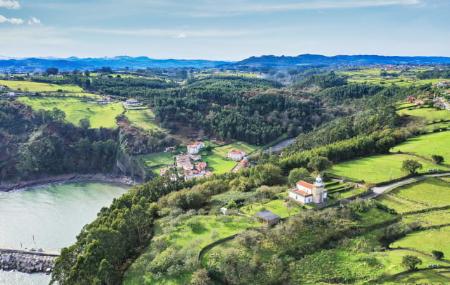
In diesem Land wird die asturische Apfelweinkultur ( Immaterielles Kulturerbe der Menschheit für die UNESCO) täglich als Gymnastik der Identität und des Widerstands praktiziert. In jeder Apfelweinmühle, in jedem Apfelweinhaus, in jedem Glas wird die uralte Vereinbarung zwischen dem Asturier und seinem "Zaubertrank" umgeschrieben. Aber zu sagen, dass diese Region nur aus Apfelwein besteht, wäre so, als würde man sagen, dass ein Fluss ohne Flussbett fließen kann. Apfelwein braucht Wurzeln: eine Landschaft, die ihn nährt, eine Geschichte, die ihn erzählt, eine Gastronomie, die ihn begleitet, und eine bäuerliche Kultur, die ihm Bedeutung verleiht.
Geschichte und Erbe des Cider Shire
Das im mittleren Osten Asturiens gelegene Apfelweinland bewahrt ein außergewöhnliches mittelalterliches Erbe, in dem sein tiefster Geist weht. Hier befindet sich die größte Dichte an vorromanischen und romanischen Kirchen in Asturien, darunter Juwelen wie San Salvador de Valdediós, San Salvador de Priesca (Villaviciosa) oder Santiago de Gobiendes (Colunga). Außerdem gehen romanische Tempel wie Santa María de Narzana (Sariego) oder San Juan de Amandi (Villaviciosa) in Santa María de la Oliva, im Herzen der Hauptstadt Mali, in eine beginnende Gotik über.

Das Erbe setzt sich in Villen und Palästen fort: die Casa de los Hevia (Villaviciosa), in der der junge Karl I. nach seiner Ausschiffung in Tazones übernachtete, der Palacio de La Ferrería (Nava) oder die stattliche Casa del Marquesado de Estrada (Bimenes). All dies wird umrahmt von der jakobinischen Route des Camino de la Costa, die zum Weltkulturerbe gehört und durch Landschaften von großem kulturellem und natürlichem Reichtum führt, bevor sie das friedliche Tal von Sariego erreicht. In Gemeinden wie Fuentes oder Sietes in Villaviciosa sind Hórreos (Getreidespeicher) im ältesten dekorativen Stil Asturiens erhalten (Villaviciosa-Stil", 14. bis 16. Jahrhundert). Auch in Torazu (Cabranes) und Ceceda (Nava) gibt es schöne "Indiano"-Häuser. Auch das Museum der Landschule von Cabranes ist ein bewegendes Fenster in die pädagogische Vergangenheit der Region.

Noch viel weiter zurück liegen die Grabhügel, Festungen und paläolithischen Stätten, aber der größte Schatz dieser Gegend ist die Juraküste. Das Juramuseum von Asturien in Colunga, das meistbesuchte Museum des Fürstentums, macht uns ganz klein vor den Dinosauriern und den Zeitaltern der Erde.
Seefahrerdörfer, Strände, Natur, Gastronomie
In diesem Gebiet kennen die Bauern die Gezeiten und die Seeleute die Apfelbäume. Die Region erstreckt sich zwischen dem Kantabrischen Meer und landwirtschaftlichen Flächen. Die Stadt Villaviciosa ist das Hauptzentrum der Bevölkerung, der Verwaltung und der Apfelweinherstellung, zusammen mit der Stadt Nava, die weiter im Landesinneren liegt.
Dörfer am Meer
Llastres, das wie ein Seiltänzer über dem Hafen thront, ist eines der schönsten Dörfer Spaniens(öffnet in einem neuen Tab) und wurde 2010 wegen seiner Tradition der Solidarität, die im 13. Jahrhundert mit der Gilde der Seeleute begann, zum Beispielhaften Dorf Asturiens ernannt. Vom Aussichtspunkt von San Roque aus kann man das Profil des Ortes als Seefahrer und den Rückgang der Sierra del Sueve zum Meer hin betrachten. Der Leuchtturm von Llastres, einsam und sehr Instagram-tauglich, beherrscht die Steilküste, umgeben von flachen Weiden und offenem Himmel.

Nicht weit entfernt, in der Gemeinde Villaviciosa, ist ein Besuch des Dorfes Tazones ein Muss: ein sehr fotogener Ort, der zwischen den Hügeln und dem Meer liegt, mit niedrigen Stein- und Holzhäusern, bunten Fassaden und blumengeschmückten Balkonen, von denen aus man auf die engen Kopfsteinpflasterstraßen blickt.
Die Flussmündung von Villaviciosa
An dieser Küste ist die Ría de Villaviciosa mit einer Fläche von 10 Quadratkilometern eine ruhige und abwechslungsreiche Flussmündung, in der sich Salzwasser mit Süßwasser inmitten von Schilf, Erlenwäldern und Sümpfen vermischt. Sie wurde zum Teilnaturschutzgebiet erklärt und ist ein Zufluchtsort für Zugvögel und ein Mündungsgebiet mit großer biologischer Vielfalt. Er öffnet sich zwischen den Stränden von El Puntal und Rodiles zum Golf von Biskaya und reicht bis zu den "Porreos", dem vom Meer zurückgewonnenen Land, das heute Feuchtwiesen und fruchtbare Ökosysteme beherbergt. Die Flussmündung und ihre Küste bieten die Möglichkeit für Wassersportarten wie Surfen oder Segeln, ruhige Bootsausflüge oder schöne Wanderungen in der Umgebung.
Strände von Colunga und Villaviciosa
In der Cidre-Region erstrecken sich die Strände unter dem Eindruck einer unberührten Natur und einer unerreichbaren geologischen Geschichte. Rodiles, das sich zum Golf von Biskaya hin öffnet und von der Ría de Villaviciosa umschlossen wird, ist einer der breitesten und dynamischsten Strände Nordspaniens. Sein geschütztes Dünensystem und die starken Wellen machen ihn zu einem beliebten Ort für Surfer. Strände wie España oder La Ñora (Villaviciosa) bewahren ihr ländliches Flair zwischen Steilküsten und sauberem Wasser. Der Strand von Merón ist eine einzigartige Enklave an der Juraküste von Asturien mit einer Spur von 20 Dinosaurier-Ichniten.

In der Nähe gibt es auch einen herrlichen Uferweg durch Auenwälder, die so genannte Ruta de los Molinos del Río Merón, auf der man hydraulische Geräte aus einer anderen Zeit entdecken kann. In Colunga fügt der Strand La Griega seinem natürlichen Charme einige der größten Dinosaurier-Fußabdrücke der Welt hinzu. Auf einem einfachen, gut ausgeschilderten Spaziergang kann man sich diesen kolossalen Fußabdrücken nähern und buchstäblich auf ihnen stehen. Der Strand La Isla (Colunga) bietet ein einzigartiges Erlebnis: Bei Ebbe kann man über ein sandiges Tombolo zu der kleinen Insel laufen, die ihm seinen Namen gibt. Die friedliche Umgebung neben indianischen Villen und Häusern mit Glasgalerien erinnert an die Sommerpracht des frühen 20. Jahrhunderts.
Naturlehrpfade
Aber in dieser Region gibt es nicht nur Küstenstreifen. Im Landesinneren wird das Wandern zur ländlichen Archäologie. Routen wie der Ríu Profundu (Villaviciosa) oder die Senda de los Molinos de Bimenes verbinden Wandern und Ethnografie und erinnern an die Rolle des Mais und der alten Wassermühlen im ländlichen Leben. Von Gobiendes aus führt der Weg zum Wasserfall von Obaya in die grüne Sierra del Sueve, das Land der Asturcones und einzigartiger Landschaften wie dem Picu Pienzu, dem Buchenwald von La Biescona oder der Tejeda del Sueve, der größten Eibenkonzentration in Europa.
Der Herbst bietet eines der größten Naturschauspiele: das Röhren der Hirsche, sowohl im Sueve als auch im Peñamayor-Gebirge, einem Gebirgsmassiv mit sanften Gipfeln, das es uns ermöglicht, zwischen Weiden, Buchenwäldern und offenen Panoramablicken in den Gemeinden von Nava und Bimenes zu wandern. Die Foces del Río Pendón, in Nava, bilden eine Schlucht von großer Schönheit.

Cabranes, das diskrete Herz des Apfelwein-Gebiets, erstreckt sich zwischen Tälern und Hügeln, die mit einheimischen Wäldern bedeckt sind. Es ist ein idealer Ort für Radtouren, mit Routen wie der Vuelta a Cabranes, einem Rundweg von etwa 30 Kilometern mit Start und Ziel in Santolaya, der Hauptstadt.
Eine weitere gute Idee ist es, mit dem Fahrrad oder dem Auto den Alto de La Campa zu erreichen. Dieser Pass liegt zwischen den asturischen Gemeinden Sariego und Villaviciosa und führt sanft ansteigend durch Wiesen, Pumaradas und verstreute Bauernhäuser. Kurz gesagt, eine Landschaft, die das ländliche Wesen dieses Landes deutlich zeigt.
Gastronomie
Im Cider Shire ist das Essen ein Ausdruck von Identität und Respekt für die lokalen Produkte. Die Küche basiert auf dem, was das Land und das Meer zu bieten haben, und zwar ganz ohne Kunstgriffe: fabes und potes, Fleisch von einheimischen Rassen wie der asturischen Kuh aus den Tälern, der pita pinta (freilaufende Hühner), dem xalda-Schaf oder dem gochu asturcelta (Schwein), dazu handwerklich hergestellte Käsesorten wie die von Ovín in Nava, Los Caserinos in Villaviciosa oder die von Saregana in Sariego, hausgemachte Wurstwaren aus Bimenes sowie Fisch und Meeresfrüchte von den Fischmärkten: "Seehecht, Wolfsbarsch, Seeteufel, Rotbarbe, Langusten, Andaricas oder Seespinnen.

Die Gastronomie geht über das Kulinarische hinaus und wird zu einem kulturellen Ereignis, mit Festen und Tagen, die jedem emblematischen Produkt Tribut zollen. So zum Beispiel die gastronomischen Tage von Gochu ( Bimenes, Anfang Dezember), das Seeigelfest in Huerres (Colunga, Ende März) oder das der boroña preñada in Torazu (Cabranes, Anfang Juni) - ein rustikales, mit Chorizo und Speck gefülltes Maisbrot aus der bäuerlichen Küche. Das Milchreisfest (Santolaya de Cabranes, zweites Maiwochenende) ist das Ereignis schlechthin für die llambiones (Süßmäuler). Die Semana de les Fabes (Colunga, langes Wochenende im Dezember) bietet spezielle Menüs in Restaurants sowie eine Ausstellung und einen Verkauf von Fabes mit Herkunftsbezeichnung und anderen Sorten.
Asturischer Apfelwein im Apfelweingebiet
Im Apfelweinland ist Apfelwein viel mehr als nur ein Getränk: Er ist ein Fest und ein geselliges Beisammensein, aber vor allem ist er ein Handwerk. Das feuchte und gemäßigte Klima begünstigt den Anbau von Apfelbäumen und ermöglicht die Gewinnung von Obstsorten, die diesem Getränk mehr Charakter verleihen. Die Region ist führend im Fürstentum, was die Anzahl der Hektar Apfelbäume und der Apfelernter betrifft, obwohl hier nicht nur Äpfel, sondern auch Kultur angebaut wird. Im Dezember 2024 wurde die asturische Apfelweinkultur von der UNESCO als immaterielles Kulturerbe der Menschheit anerkannt, ein lebendiges Erbe, das diese Region wie keine andere verkörpert.

Weintouristische Veranstaltungen und Erlebnisse
Villaviciosa und Nava sind zwei große Apfelwein-Referenzen in Asturien. Villaviciosa zeichnet sich durch eine große Anzahl von Apfelweinkellereien aus, darunter so bekannte Marken wie El Gaitero, und durch die Vielfalt der Apfelweine: natürliche, prickelnde und neuartige Apfelweine oder Tafelweine (letztere müssen nicht eingeschenkt werden). In Nava wiederum befindet sich das Apfelweinmuseum, und jedes Jahr im Juli findet das Fest des natürlichen Apfelweins statt (ein Fest von nationalem touristischem Interesse), ein unumgängliches Ereignis, bei dem die Menschen in Strömen auf die Plätze strömen, sich im Wettbewerb um den besten Apfelweinausschank oder die beste Apfelweinproduktion messen und mit Natürlichkeit und Stolz darauf anstoßen.

Im Juli findet in Sariego der Wettbewerb für hausgemachten Apfelwein statt, eine Verkostung, bei der die Einheimischen ihren Apfelwein vorstellen, der auf traditionelle Weise hergestellt wird, nur mit Takt, Zeit und bäuerlicher Weisheit. Ähnliche Wettbewerbe werden im August in Villaviciosa und im September in Nava veranstaltet. Ebenfalls im September feiert Villaviciosa sein Apfelweinfest, bei dem die professionelle Produktion der Apfelweinhersteller im Mittelpunkt steht. Das große Ereignis in Mali findet jedoch im Oktober statt, und zwar das große Apfelfest (ein Festival von touristischem Interesse im Fürstentum), das alle zwei Jahre die Stadt mit Aktivitäten füllt: Sortenausstellungen, Apfelweinwettbewerbe, Fachkonferenzen, Lebensmittel- und Landwirtschaftsmärkte und ein intensives Kulturprogramm.
Neben den Feierlichkeiten bieten mehrere Apfelweinhäuser im Apfelweingebiet weintouristische Veranstaltungen an, bei denen die Besucher den Prozess der Apfelweinherstellung aus nächster Nähe kennen lernen können. Im Rahmen von Führungen können die Besucher den gesamten Zyklus - vom Apfelbaum bis zum Glas - verfolgen und geführte Verkostungen und Kombinationen mit lokalen Produkten genießen.
Tipps für das Cider Shire
Wenn es um Apfelwein und Apfelbäume geht, hat dieses Gebiet einen obligatorischen Kalender. Der Frühling, zwischen April und Mai, ist ein wahrer Augenschmaus. Die Apfelblüte verwandelt die Obstgärten, die plötzlich erwachen und sich in einen flüchtigen Mantel aus Weiß und Rosa hüllen. In der ersten Maiwoche werden in der gesamten Region zahlreiche Aktivitäten rund um die Blüte organisiert, wie z. B. Besuche der blühenden Apfelplantagen, aber auch der ländlichen Apfelweinhäuser, die die Geheimnisse des natürlichen Apfelweins bewahren. In Restaurants, Apfelweinhäusern und Mühlen werden Apfelweinmenüs und Apfelweinverkostungen angeboten.
Der Sommer mit seinem langen Licht und dem guten Wetter ermöglicht es uns, eine Region voll und ganz zu genießen, die alles hat: Meer und Berge, ein beneidenswertes Kulturerbe, Fischerdörfer, schöne Weiler und eine großzügige Gastronomie, die uns zu "Wiederholungsurlaubern" machen will.

Der Herbst markiert den Höhepunktdes Apfelweinzyklus in Asturien. September und Oktober sind die wichtigsten Monate für die Apfelernte. Es ist Zeit zum "mayar", zum Füllen der Fässer. Die Arbeit ist in vollem Gange und viele Mostereien öffnen ihre Türen, um zu zeigen, wie Apfelwein hergestellt wird. Darüber hinaus bieten viele Unterkünfte spezielle Pakete an, um das Apfelweinerlebnis zu optimieren.
Und wer glaubt, der Winter sei eine unwirtliche Zeit, der irrt. Im Apfelweinland steht das Leben nicht still: Die Wälder sind mit Moos bedeckt, das Meer rauscht mit Wucht, die Täler sind nebelverhangen und in den Küchen wimmelt es von Töpfen und dampfenden Kesseln.
Jede Jahreszeit hat ihre eigene Geschichte, ihr eigenes Licht und ihren eigenen Geschmack. Deshalb reicht ein einziger Besuch nicht aus, man muss wiederkommen, immer wieder.
Bildergalerie
Landkarte
Was ist sehenswert
- Die 10 besten Dinge, die man im Cider Shire sehen und tun kann.
- Die Mühlenroute in Bimenes.
- Das Museum der Landwirtschaftsschule und das Dorf Torazu in Cabranes.
- Der Fischerhafen von Llastres und das Juramuseum in Colunga.
- Das Apfelweinmuseum und die Peñamayor-Berge in Nava.
- Die Wanderroute Las Cercanías del Cielo und die romanische Kirche Santa María de Narzana in Sariego.
- Der Fischerhafen von Tazones und die vorromanischen und romanischen Bauwerke von Valdediós in Villaviciosa.



